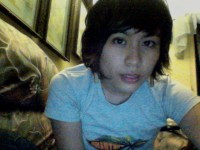Interview with Christine Lee Zilka and Jennifer Derilo of the Kartika Review
I’ve always been curious about the darkroom where literary magazines come together. This is a series of interviews engaging, talking, and sometimes annoying editors about their magazines. How did they come about, what do they hate about editing, and what do they love most about it?
This is the third in the series and I talked with Fiction Editor, Christine Lee Zilka, and Creative Nonfiction editor, Jennifer Derilo. Their about page has the following description: “Kartika Review is a national literary arts magazine that publishes Asian Pacific Islander American fiction, poetry, creative non-fiction, and art. Kartika Review serves the Asian Pacific Islander American (APIA) community and those involved with Diasporic Asian and Pacific Islander-inspired literature. We scout for compelling APIA creative writing and artwork to present to the public at large. Our editors actively solicit contributions from established virtuosos in our community in hopes their works here will inspire the next generation of virtuosos. Kartika also promotes emerging writers and artists we foresee to be the future powerhouses of their craft. Ultimately, Kartika strives to create a literary forum that caters to and celebrates the wordsmiths of the Asian Diaspora.”
What’s always drawn me to the review is their focus on great stories. The APIA experience is incredibly diverse and the Kartika Review pushes the boundaries of what constitutes APIA literature. The settings may differ and so may some of the sentiments of the narrators, but at the core, the emotional resonance transcends any differences. The tales, poetry, essays, and imagery form a unique flotilla of art that is as portable as it is relatable. I hopped on board with the two editors and what followed was an organic and fun trek through the editorial rivers of the review.
***
As a brief bio and introduction to Christine (CLZ) and Jennifer (JD):

Christine Lee Zilka is the Fiction Editor at KARTIKA REVIEW. Her work has appeared in journals and anthologies such as ZYZZYVA, GUERNICA, VERBSAP, HYPHEN, and MEN UNDRESSED. She has a novel in progress.

Jennifer Derilo is the Creative Nonfiction editor at Kartika Review. She has a memoir in progress. She often has nightmares about zombies. And abandoned predicate parts.
***
PTL: When and how did you first get involved with Kartika Review?
CLZ: I subbed a short story for consideration to Kartika in early 2008–and I got an email from Sunny Woan, our Founding Editor, saying she loved the piece and wanted to know if I would be interested in becoming Kartika’s Fiction Editor (the previous Fiction Editors departed after Kartika’s second issue). I told her yes! It was my call whether or not to have the piece published; I’m not a big proponent of editors publishing their own work at the litmag for which they work, so I withdrew the piece. The rest is history. I found a passion project in Kartika Review and a fantastic friend in Sunny. And recently, that story just got accepted for publication in another litmag. I owe a lot to that story.
JD: Christine and I were in the MFA program at Mills, but she was in the cohort ahead of me. I first met her when she was the TA for a teaching pedagogy class during my first semester in 2006. While she was an excellent TA, she also coaxed me out of my shell. I started to see her as a big sister type who had the best advice about classes, professors, the program itself, and eventually writing. We kept in touch after we both graduated (I kept going to her for advice!), and then sometime in 2008, Christine asked me to submit something to KR, but in true Jenn Derilo fashion, I never did. And then in 2009, she asked me to join because the CNF editor before me was moving onto other things. I’m sorry for all that backstory about my friendship with Christine, but if I didn’t initially glom onto her (ok…that’s not supposed to sound as creepy, stalker-ish, aggressive as it might), I don’t know that I would ever have been exposed to KR. I was such a writing/literary n00b when I started Mills, and I certainly knew nothing about APIA literature. But she talked about Kartika with such passion, and I was so impressed with the work they were doing, I couldn’t not join. I was supremely honored.
CZ: Jenn is modest. She’s an awesome writer. And has done amazing things as an editor at Kartika.
JD: Aw, shucks. Thank you. I’m lucky to be on an editorial board with multi-talented women of color. And I can’t stress that enough: women of color.
PTL: Christine, I really liked it when you said in regards to your editorial selections: “I often pick pieces by Asian Americans that aren’t API-centric. There are no rules, and Naomi Williams breaks them with brilliance.” What are some works that you both think exemplify Asian Pacific Islander American (APIA) literature, and how did those works affect and influence you?
CLZ: Twenty years ago, this question would have had a more clear cut answer. I would probably have said Maxine Hong Kingston’s WOMAN WARRIOR or Chang-rae Lee’s NATIVE SPEAKER. To that end, I’m motivated both as a writer and as an editor to broaden APIA literature. I’m happy to say there’s no single work that stands out to me, anymore. And I’m also happy that I’m a gatekeeper who gets to have a hand in diversifying the pool. I’m in front of a verrrry small gate, but it’s a gate, nonetheless.
JD: While I know this question is directed at Christine, I can’t help jumping in and agreeing with her, especially given that my knowledge of APIA literature was limited before joining KR. I even knew little about the APIA cannon. But what we do at KR is different. I do feel like we’re “diversifying the pool”, such as including the work of emerging writers alongside interviews with household names. We aren’t only publishing APIA writers who engage with APIA themes. I think Christine nails it when she says, “I’m happy to say that there’s no single work that stands out to me, anymore.” I mean, wow. What a brave discovery to voice! This is not to say that no submissions stand out because, clearly, we publish those pieces shake us. What’s important about that statement is that no one work encapsulates, defines, pigeonholes APIA literature. Rather each work broadens this scope.
PTL: I love the definition of “Kartika” as mentioned on the site: “In Vajrayana (or Tibetan) Buddhist tradition, the kartika, a crescent-shaped knife, symbolizes the cutting away of ignorance and superficiality, with the hopes that it will lead to enlightenment.” What are some themes and elements you both look for in the selections you make for short stories and non-fiction essays?
JD: I don’t know if this is cliche, but I’m attracted to creative nonfiction that surprises me. Even if submissions are about common themes, if the approach to language, structure, or voice is undeniably fresh or risky, I quickly gravitate toward them. It’s difficult to pinpoint exactly what floors me. The best way to understand my madness is to read our back issues starting with #6, which is, of course, when I joined.
CLZ: When I’m looking through the slushpile, pieces tend to blur into each other—so I too, am looking for something different. I’m looking for stories that hit something out of the ballpark, be it concept, structure, language, or ultimately, story. What haven’t I seen before?
